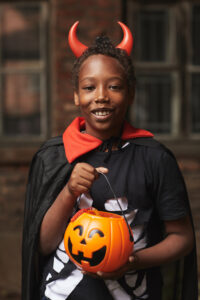Autism and Halloween: For many, the spooky season is a time of excitement. People eagerly shop for scary costumes, set up spooky sounding animated figures, and devour buckets of candy. Children get excited about all the treats they will get, the festivals, and school celebrations.
For an autism family, Halloween can be a very different story. Those scary costumes can be a trigger, and itchy costumes can set off tactile or sensory sensitivities; spooky animated creatures can be overpowering and the large crowds and loud noises at Halloween festivals can be overwhelming. For many of us with autistic children, we would rather skip it all together. However, we also deeply desire for our children to experience those holiday traditions, and for those with neurotypical children in the home as well, the wish is for them to enjoy the full Halloween experience. The challenge becomes how to make this spooky season enjoyable for everyone.
As an autism mom of four, all with varying needs, I have had that struggle. I understand the worry and anxiety that builds as we anticipate potential overstimulation and responses to triggers. There are a few things that I have found extremely helpful in the past and share them with you here.

Plan
As much as we would like to participate in all the activities, the reality is that time and other circumstances just won’t allow for that. I make a list of all the festivities we are considering and do a thorough mental recall of how these events worked in the past. What was our experience? How overstimulating was it? Was this an event worth considering again? If it was too much last time, I mark it off my list of options. If it’s a possibility, I leave it on the list and continue to narrow the list down to three or four activities, trying to choose those activities that can take place over a period of a couple of days.
Do a run through
About a week prior to the event, I drive to the event location. While there we discuss what’s going to happen and do a countdown of the number of days until we come back—for example, “In five days, we will put on our costumes and come here to see lots of cool costumes. There will be cars set up here with cool decorations, and we will say ‘Trick or Treat’ at each one as we carry our Halloween buckets. They’ll give us treats in our buckets.”
Place the event on your child’s visual schedule
Visual schedules are a lifeline for families on the spectrum. Just as many of us live by our calendar, a schedule helps reduce anxiety and teaches our children what to expect in their day.
Prepare a Halloween emergency kit
 We all know that the unexpected happens and preparing a Halloween emergency kit can be a lifeline for success in those moments. Here are some things we have found useful in the past:
We all know that the unexpected happens and preparing a Halloween emergency kit can be a lifeline for success in those moments. Here are some things we have found useful in the past:
• Halloween pajamas: Let’s face it, costumes are ITCHY! If your child insists on a costume instead of comfort, there may be a point in the night where they become overstimulated by tactile issues and decide they want it OFF. This can often happen in the middle of an event, or it can happen when your other children are not ready to call it a night. Halloween PJs can be a quick change in the car and ensure the night’s festivities can continue in comfort. Another perk is that the bedtime struggle is lessened a little as they are already in nighttime attire!
• Headphones or earplugs: When sound gets too loud, pull those headphones out of the bag and pop them over the ears to reduce the frustration with the noise around them. Some children don’t like the attention headphones can bring so ear plugs are a great option that masks their noise sensory sensitivities while allowing them to enjoy their surroundings.
• Fidgets: Sure, there will be a lot going on with trick-or-treating and sometimes our individuals on the spectrum just need a little escape. A few minutes with mom carrying the Halloween bucket and time with a favorite fidget can allow them the space they need to escape into a zone of comfort.
• A comfort item: All of us have a favorite thing that makes us feel at peace. For many years, I couldn’t sleep in comfort without a blanket that used to belong to my grandmother. If I was sick, that was the blanket I wanted to be wrapped in. Our children also have their own special comfort items. It could be a stuffed animal, a book, or a favorite toy. Having this item available in the emergency kit will give them quick access to something that puts them at ease.
• Special treats: If your children are like mine, they are sensory eaters. My son has one brand of fruit snacks that he devours, and I travel nowhere without these in my emergency kit. Sometimes hunger can be a trigger for our children, too, and this is an easy way to avoid hunger while providing comfort.
Autism and Halloween doesn’t have to be a stressful mix. Just like many events or occasions in our lives, with the right preparation and by taking a few extra steps, we can all enjoy this special time of year.
 More resources for a happy Halloween
More resources for a happy Halloween
• Social narrative: Trick-or-Treating
• Blog: Making Halloween Fun for Individuals with Autism
• Social narrative: Time change in the fall
Check out the Autism Society of North Carolina’s calendar webpage for upcoming Halloween events, like Support Group Trunk-or-Treats, and more.
Go back
